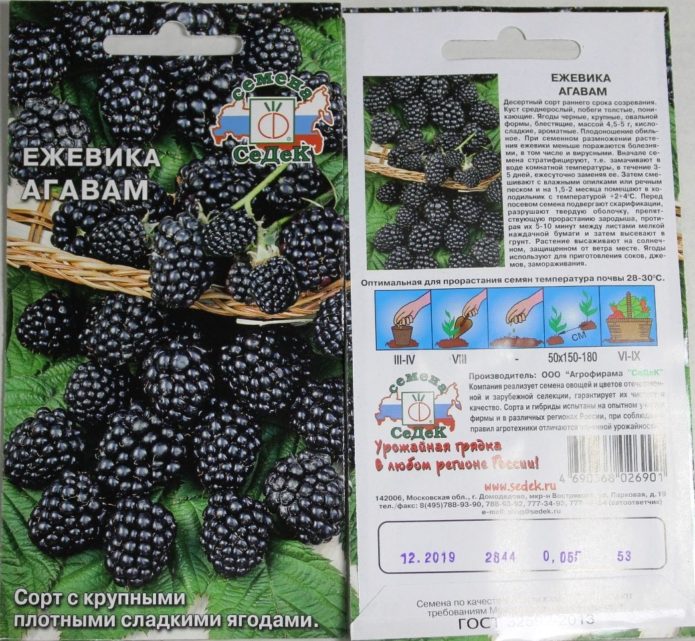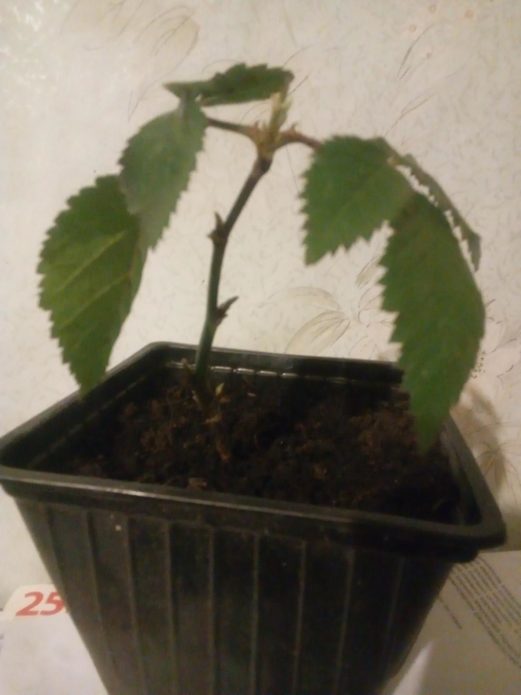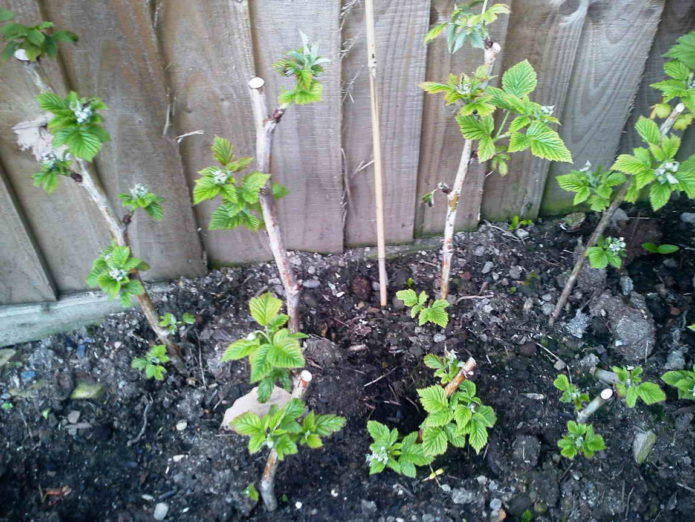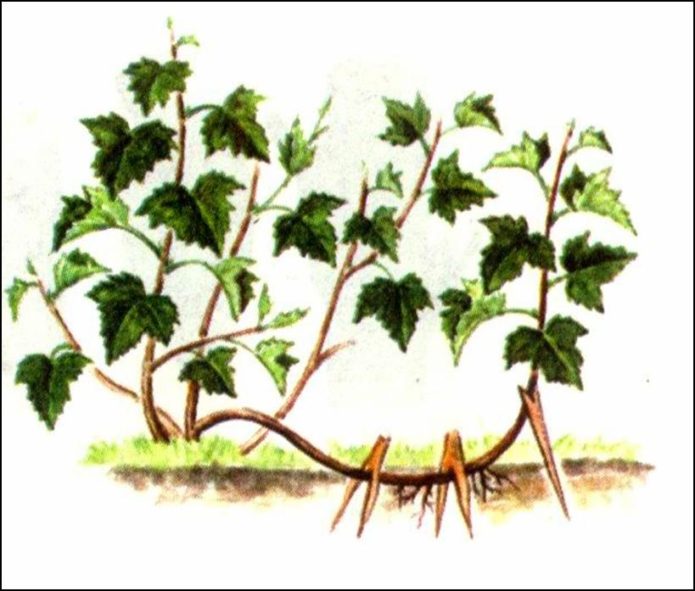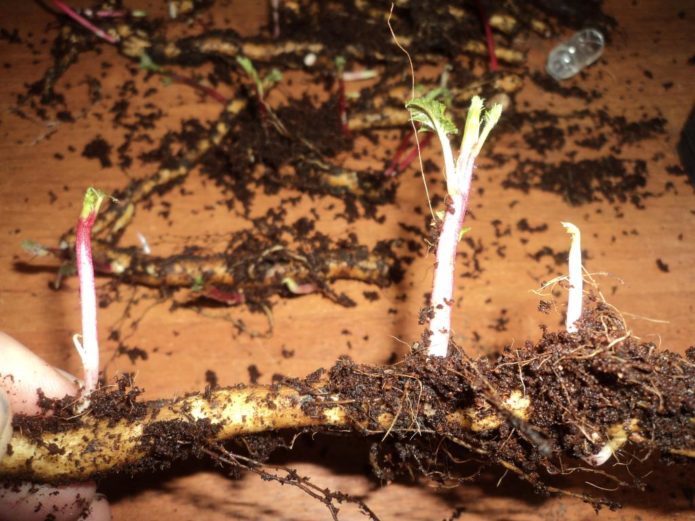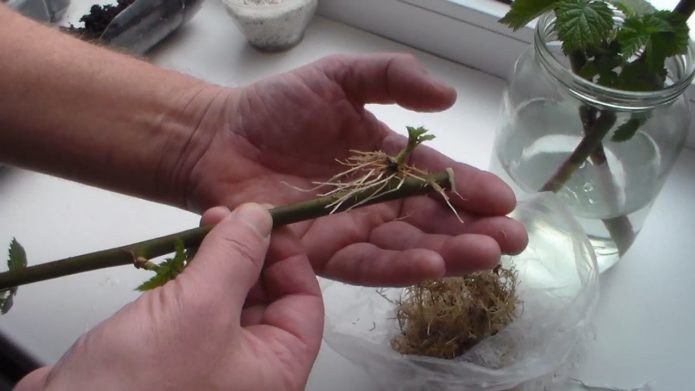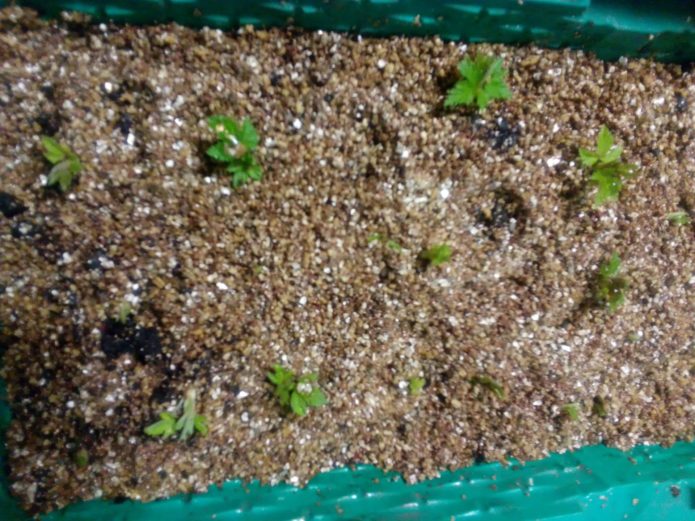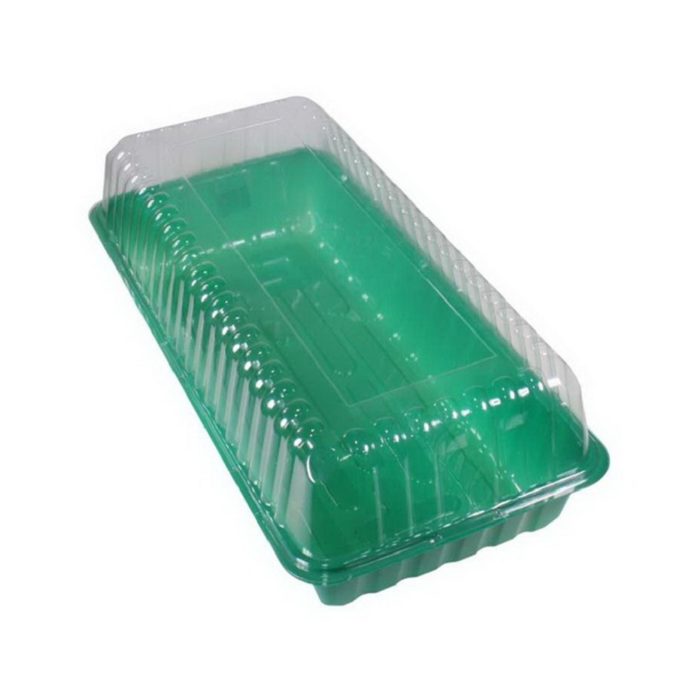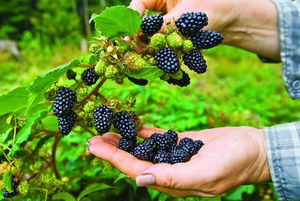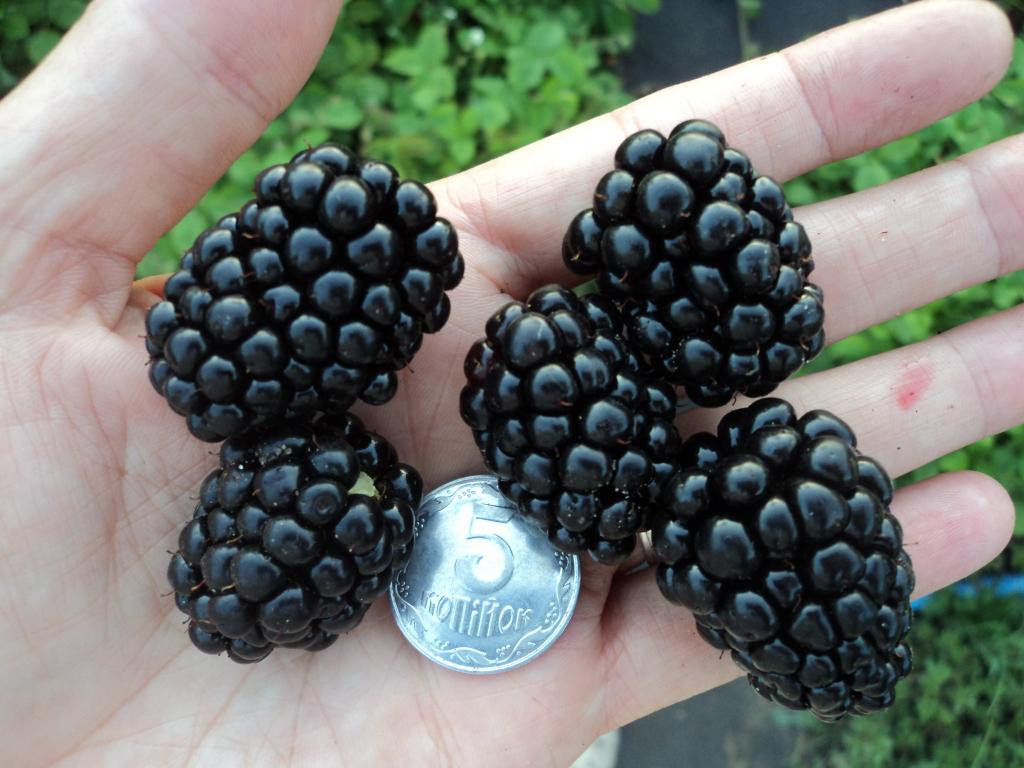Blackberry seedlings, even prickly ones, are not cheap. And, if the acquired bush pleased with the yield and taste of berries, there is a desire to multiply it.
Content
How blackberries reproduce
You can grow blackberry seedlings at home or in a greenhouse, and some varieties are propagated directly in the beds. Creeping varieties and drooping species, intermediate between straight-growing and mildews, take root at the top of the stem. Others give root suckers like raspberries.
Besides, blackberries are propagated cuttings or horizontal layering (dropping young shoots). Saplings of many thorny varieties are obtained by germinating root cuttings in greenhouses or indoors. There are even blackberry seeds on sale.
Is it possible to grow blackberries from seeds
Although new varieties of blackberries are obtained by sowing seeds obtained by manual pollination of flowers, this crop is propagated mainly in a vegetative way, that is, by rooting parts of the plant.
Large-fruited and remontant plants are obtained by complex hybridization of various blackberry species, and it is pointless to sow the seeds collected from them.
Seedlings begin to bear fruit in the third - fourth year after sowing.
Why propagate blackberries by seeds
Nurseries sell modern varieties - large-fruited, with berries weighing 8-16 grams, but requiring shelter for the winter and mandatory treatments from diseases and pests.
Some varieties declared by the manufacturer as not requiring shelter for the winter, such as Brzezina, Ebana, Chachanska Bestna in the conditions of Belarus and in most of Russia, have to be sheltered. This is not convenient for everyone.
And the old varieties, such as Agvaam, Izobilnaya, Ufimskaya local with berries weighing 3-4 grams, are not bred by professionals.
It is dangerous to take seedlings from grandmothers in the market, suddenly you bring some kind of infection into the garden. And with seeds - no risk.
If the package says that the berries weigh 6–8 grams, you should not buy seeds: it is not clear from which varieties they were collected. But the promise of amazingly sweet berries is a slight exaggeration.
Seedlings grow very slowly.
But for regions with cool and cold climates, sowing has many advantages.
Plants from seeds (not only in blackberries, but in most plants propagated vegetatively, potatoes, garlic, etc.) are more resistant to diseases, pests, and the vagaries of the weather. It is even better if you collect and sow seeds from ripe berries on the best seedlings. Michurin was already convinced of this in his experiments.At the first sowing, only 40% of the seedlings had all the necessary properties, and those grown from seeds selected from the best of these bushes turned out to be more productive and hardier than the mother plants.
All the rules for growing blackberries: we plant, form, propagate and process from pests:https://flowers.bigbadmole.com/en/yagody/ezhevika-uhod-i-posadka.html
How to sow blackberries
Getting blackberry seeds to germinate is not easy.
For them to hatch, stratification is needed, that is, long-term storage of moist seeds at temperatures close to zero. First, the seeds are thoroughly washed and soaked in water without chlorine for a day. Then mixed with thoroughly washed and calcined wet sand... The latter is taken 1-2 tablespoons, the mixture is poured into a clean disposable container with a lid and sent to the refrigerator.
Blackberry seeds germinate best if the temperature for the first two weeks is slightly above zero, then they are kept for about a day at -50C, and then about a month at +20C - +50C. In this case, the mixture should be checked every week and, if necessary, moistened. You can, of course, keep the seeds at freezing temperatures for the entire period. But then the period between sowing and germination will be one and a half to two times longer. It is important to open the container twice a week and ventilate for a few minutes.
If there is no time for stratification, scarification is carried out - artificial damage to the seed coat. There are different methods, but the easiest to use is mechanical scarification. Dry seeds need to be scratched. With small ones, like blackberries, they do this. A cut piece of sandpaper is placed in a small plastic box to completely cover the bottom. The seeds are mixed with a teaspoon of fine sand and poured into a box. Then the mixture of seeds and sand is rolled over the sandpaper with a small plastic lid. No effort, the seeds must be scratched, but not flattened.
Then disinfection - in a solution of potassium permanganate (0.5 grams per 0.5 liters of water) for 15 minutes, followed by rinsing, or for a day in a solution of phytosporin (8-10 drops per glass of water).
Soil for sowing seeds is made up of a mixture of peat of an average degree of decomposition and vermiculite in a ratio of 5 to 1. Drainage is poured at the bottom - agroperlite, fine expanded clay or sand. The surface of the soil poured into boxes or pots is leveled and slightly compacted, watered. Seeds are sown at a distance of one and a half centimeters in a row and two - between rows. Each seed is pressed to the soil, and sprinkled on top with sand or vermiculite, with a layer of 4–5 mm.

When sowing, the seeds are laid out on moist compacted soil, and on top they are covered with a light substrate with a layer of 5 mm
The box is covered with glass, the pots can be with cling film. Before the emergence of seedlings, they are aired twice a week, and with the emergence of seedlings - daily. Germination temperature 22-260 C. Drizzle with water at room temperature, under the root of a teaspoon, in moderation, avoiding dampness. From sowing to germination - 2 to 4 weeks. If a month and a half has passed, and there are no shoots, either they overdid it with watering, or the seeds are of poor quality.
Seedling care
After sprouting for 4–5 days, tiny plants are gradually accustomed to fresh air, opening for 15–20 minutes 1–2 times a day. During this period, illumination is indispensable. With the appearance of the second true leaf, the seedlings dive. It is important not to damage the tip of the main root.
Top dressing begins after the appearance of the first true leaf between the cotyledons, The first time the seedlings are sprayed from a spray bottle with a weak solution of Fitosporin, the dosage is half that indicated on the package. After 2-3 days, feed under the root with the same solution.
The time of sowing seeds, depending on the date of the proposed planting. Seedlings by the time of relocation to a greenhouse or greenhouse should be at least 30 days old, and 45 for temporary shelters.In the northern regions they are planted in June, when the threat of frost passes, in the southern ones - in early September, since in spring the seedlings do not have time to take root before the onset of heat. Residents of Central Russia, the Black Earth Region, South and Western Belarus can plant seedlings both in May and at the end of August, but always under cover, in a greenhouse or greenhouse.
Young plants are planted according to the scheme 30 by 20 centimeters in a loose, organic fertilized soil with a slightly acidic reaction. If you plant without destroying the earthen ball, 100% of the seedlings will take root.
Before freezing, bushes growing in open ground are slightly huddled.
They are planted in a permanent place next spring.
Planting and transplanting blackberries, although they have some nuances, is not so difficult that even a person far from gardening cannot cope with this:https://flowers.bigbadmole.com/en/yagody/posadka-ezheviki-vesnoy.html
Vegetative propagation of blackberries
You can get a lot of planting material from your favorite bush by cuttings. To obtain seedlings, green cuttings, ligneous young stems with developed buds and even roots cut into pieces are used.
Blackberry propagation by green cuttings
Young shoots are cut from the bushes with a sharp knife. One or more seedlings can be obtained from one replacement shoot. In the first case, as soon as the length of the young stem reaches 12–17 cm, it is cut off 2.5–3 cm below the soil level. The top is not pinched. They are planted vertically.
Cuttings are planted densely, up to 300 pieces per square meter. Sand is poured onto the surface of the soil in a bed with a layer of 1 cm.In the early days, the leaves on the cuttings are sprayed daily.
If planted in open ground, cover with thin agrofibre (density 17–20 grams per meter). When planting in containers, the substrate is a mixture of peat with agroperlite (3 to 1).
To increase the survival rate, they are sprayed with Zrcon twice a week (2 drops per liter of settled water).
In the second variant, a shoot 60–70 cm long is cut into pieces with one or two buds and one leaf (the lower one, if any, is cut off). When planting, the lower bud is in the sand, but above the soil surface. The upper cut is just above the kidney.
Cuttings are planted densely, up to 300 pieces per square meter. Sand is poured onto the surface of the soil in a bed with a layer of 1 cm.
Video: cutting green cuttings
You can root in a greenhouse, on a prepared bed, covered with agrofibre, and even in an apartment.
Shade the landing for two weeks from the moment of disembarkation. In addition, cuttings require high air humidity. The leaves are sprayed every evening. In greenhouses using artificial fog, 100% of cuttings are rooted, in the beds and windowsills - up to 70%.
But in the room and in the greenhouse there is a high risk of fungal infections, treatment with fungicides is required for prevention. It is recommended to use Topsin-M or Fitosporin in the apartment.
Blackberry propagation by root suckers
Some varieties of tall blackberries give shoots from the roots up to 60 cm from the bush. This overgrowth is removed so as not to drain the bush and to avoid thickening. But you can use it as a planting material.
As soon as the height of the shoots reaches 10-15 cm, they are carefully dug out, being careful not to damage the roots of the bush. Each shoot is planted in a two-liter container with loose soil and placed in a shaded place for 2 weeks.
To create optimal humidity, you can make individual mini-greenhouses: cover each seedling with a two-liter plastic bottle without a bottom, remove the cap.
The seedlings are ready for planting in a place with a clod of earth by September.
From upright adult blackberry bushes, you can easily get more than a hundred seedlings in two years. There is only one limitation - only suitable for thorny varieties. A circle with a diameter of 1 meter is drawn around the bush and a groove is dug around the circumference on the bayonet of the shovel. The resulting depression is immediately poured abundantly with settled water and filled to the brim with a mixture of humus and sand.Next spring, 30 to 70 lateral shoots will grow around the bush. The bush itself is fed with organic matter every 10 days, 1 lira of the finished solution. And the shoots are watered, preventing the soil from drying out or excess moisture. With the onset of heat, the soil is mulched in a circle with straw or dried grass.
In August, they are cut off from the mother bush and planted on a seedling bed. The mother bush is used for reproduction for another 2-3 seasons, and then uprooted. He will not give berries, only shoots.
Propagation by horizontal layers
The method is easy and safe for the mother bush. It is used on straight-growing varieties and hybrids, including remontant ones. The young shoot, as soon as its length reaches 40 cm, is carefully bent to the ground. The stalk during this period is flexible, it is pinned to the loosened soil, watered and the central part is sprinkled with loose soil with a layer of 3-4 cm.
The apex itself will take an upright position in two to three days. Mulch with straw or a piece of agrospan so that the soil does not dry out. Two or three times a season they are watered with Kornevin or Zircon solution. In mid-August, they cut off the shoot from the bush with a clean pruner, and in early September, in regions with a warm or temperate climate, they carefully dig in, trying not to damage either the roots of the mother plant or the young seedling. Rooted layers are planted in a greenhouse or greenhouse, the distance is 40 by 40 cm. The depth is the same as it was in the garden bed. Watered with Kornevin, a liter per plant. A year later, they are planted in a permanent place.
Blackberry propagation by dividing the bush
This method helps to get 4-5 ready-made seedlings from one plant.
In early spring, before bud break, the selected bush is carefully dug out, being careful not to damage the lateral roots. Then cut it into pieces, so that each one has one or two annual shoots and a well-developed root. Delenki are thoroughly cleaned of the remnants of rhizomes and old stems, cut off the damaged ends of the roots, shorten the aerial part, leaving 30–40 cm if there is only one shoot, and 20 cm each if the separated part with two annual stems. All cleaned places and cuts are smeared with greenery from the first aid kit.
The resulting seedlings are immediately planted in the prepared holes, slightly dusting the roots with Kornevin or another suitable stimulant. In hot weather, they are shaded. And cut off all the buds without waiting for flowering. Prevent the soil from drying out. By the next season, strong bushes will have formed that can give a good harvest.
Rooting the tops of blackberry shoots
In creeping and drooping forms of blackberries, in May - June, the tops of molded shoots are cut off. The length of the shoot at the time of cutting is 40-50 cm. Cut off not the very tip, but a part of the stem 10-11 cm long. This procedure will provoke the growth of lateral shoots. By the end of summer, the ends of the branches begin to thicken. as soon as they touch the loose, moist soil, roots will appear. It is not necessary to sprinkle it with earth for rooting, but before the expected frost, sprinkle it, sprinkling loose soil with a mound to the rooted tip. In the spring, the poured soil is carefully raked off, the seedlings with a clod of earth are transplanted to a permanent place.
Microcloning
Saplings from cuttings are not exactly the same. Some differ in the power of the bushes, others in yield. Even the size of the berries may vary. But in laboratories, scientists can make an exact copy of a selected specimen from a tiny piece of cloth. Hundreds of thousands of microscopic copies are obtained from one plant per year. Tiny sprouts are placed in test tubes, then planted in sterile boxes, and then in specially equipped greenhouses. Such seedlings are further used for scientific purposes. The cost of seedlings grown in a test tube is very high, over 1000 rubles each.
List of successful varieties and hybrids of blackberries:https://flowers.bigbadmole.com/en/yagody/ezhevika-sorta-opisanie-foto.html
Choosing bushes for grafting
Only acquired young plants are not used for cutting cuttings, even green ones.
After transplanting, the bush directs all its forces to take root after transplanting. Strong, healthy plants are needed, transplanted at least 10 months ago.
Blackberry propagation by root segments
If you intend to cut root cuttings, consider the following:
- Thornless varieties, when propagated by roots, can give thorny plants (while the remaining characteristics of the variety are preserved);
- The plant from which the roots were cut will not be able to be used in the future to obtain berries, but only for reproduction;
- The thickness of the root cuttings affects both the speed of awakening of growth points and the viability of young shoots. In theory, sections with a thickness of 3 mm or even less are suitable. But practice shows that the optimal diameter of the roots for grafting is from 5 to 8 mm. You should not destroy good bushes if they have less roots.
- Creeping blackberries reproduce well by rooting the tops, cuttings with this are not cut. There is no point in this, a four-year-old bush, under certain conditions, is capable of producing up to 30 seedlings ready for planting per season.
- If you plan to cut seedlings, it is important to first make sure that the specimen is of suitable quality - it does not give abundant root growth, the berries are of good taste and a sufficient part of them will have time to ripen. Until the bush gives a full harvest, this is impossible to understand. But you can root 2-3 tops from a bush. Just do not rush to distribute the resulting seedlings to friends or acquaintances until you are sure of the quality.
Cut the roots into pieces 5–6 cm long just before planting. Until that moment, they are stored in a slightly moist, loose substrate (for example, a mixture of peat and sand).
The best results are obtained by planting root cuttings in the greenhouse in March - early April. The soil at this time is still cold, and it must be spilled with boiling water, and on top of it pour nutrient soil, warmed up in the room to room temperature. The composition of the substrate is a bucket of peat and humus and half a bucket of sifted sand.
Before planting, the roots are soaked for two to three hours in Fitosporin solution. They are laid out on the surface of the poured substrate in rows so that it is convenient to care for the grown sprouts. Cover the top with the same substrate with a layer of 4–5 cm and sprinkle with Fitosporin. This drug will prevent diseases of future sprouts. Arcs are installed on top and the covering material is pulled.
You can grow seedlings from root cuttings and in the room. In this case, backlighting is required.
You can start germination from mid-January, then a 0.5 liter pot will be enough for plants before planting in a greenhouse or greenhouse. The roots are washed, then soaked in Fitosporin and after 2 hours the cuttings are cut with a sharp knife and planted in boxes. The soil is made by mixing peat with agroperlite or vermiculite in an arbitrary proportion. You can even take pure perlite, but more often they take 4 parts of peat for one part of perlite.
Within a week, the first shoots appear, within three weeks after planting, all cuttings will germinate. It is better to plant roots of various thicknesses in separate boxes or containers: sprouts from those that are thicker are ready for picking into cups earlier.
Before planting, the boxes are watered abundantly, it is easier to remove the seedlings from the soaked substrate without damaging them.
At the bottom of the glass, which has holes for water drainage, drainage is poured with a layer of about a centimeter. Then, up to half the height, they are covered with a mixture of humus with peat and the addition of perlite. Then add some clean peat. The upper part of the glass is filled with a mixture of peat with perlite 1 to 1. The roots of the seedlings should neither bend during planting, nor touch the nutrient mixture with humus. Until they take root, the roots are in the upper part, where there is only peat and perlite.When growth begins, the roots will quickly reach a fertile mixture.
Waterlogging and cold in the first two weeks after transplantation are destructive.
For any suspicious change in leaves, even on one plant, do a tick treatment. Aktelik can be used in the apartment.
Video: Master class on growing blackberries from roots from a specialist
Winter storage of blackberry stem cuttings
From well-ripened sections of the stem at home, seedlings of varieties that do not have thorns, as well as remontant blackberries, which do not give root suckers, are obtained. The upper quarter of the shoot is not suitable for cuttings. Cutting the stems into cuttings is done immediately before germination.
If there is a greenhouse, lay the stems, without cutting off the tops, horizontally on the soil surface, and sprinkle slightly moistened peat on top with a layer of 15–20 cm. In February, they are dug out, cut into cuttings and rooted. If the stems are laid on a board, it will be easier to dig up.
But if the dacha is far away, the cuttings are stored in the refrigerator. They are cut into pieces 35–40 cm long, and small potato tubers are planted at the ends. Small cuts are made in the tuber, and up to 5 stems can be inserted into each. Then it is wrapped in a dry linen cloth, placed in a bag and stored in the refrigerator or in a cold cellar (temperature not higher than +80 C).
Rooting stem cuttings
Lignified blackberry cuttings can be rooted in an apartment in winter, and ready-made seedlings are obtained by spring.
If you just put the blackberry sprigs in a jar of water, the roots will not appear. The flexible stems are rooted by securing the upper end of the curved shoot in a cup filled with moist peat soil. After three weeks, sprouts appear from the buds at the top.
If the stems are tough, wrap the upper end with wet moss, on top - a film, and tie. The roots will appear in about 2 weeks.
It is much easier to root cuttings in containers with a mixture of peat and agroperlite.
The sprouts appear in the second week of germination. Therefore, in order to get high-quality seedlings, cuttings are "planted" two months before planting blackberries in a greenhouse or greenhouse.
For rooting, take containers with a depth of 7-10 cm with transparent lids.
Before planting, cut cuttings with 2-3 ripe buds are disinfected for 15-20 minutes in a bright pink solution of potassium permanganate, then soaked in water for 10-12 hours.
They are planted horizontally, then all the buds will give both roots and leaves to a depth of 2-3 cm.
When the sprouts reach a height of 4–5 cm, they are seated. The substrate is made from a mixture of humus and soil, steamed in a water bath for 2 hours, and sand and peat.
You can plant a cutting with 2-3 sprouts or cut into pieces and grease the slices with greenery.
Important! The cups should not be pressed tightly against the pallet; a gap is required.
If the room is hot, the leaves are sprayed from a spray bottle.
The most important thing is to prevent waterlogging of the soil and provide the seedlings with lighting for 12-14 hours a day.
The seedlings are ready for planting in a permanent place in September, but more often they are left in the greenhouse until spring.
If desired, any gardener, even a beginner, can propagate a favorite blackberry variety.
